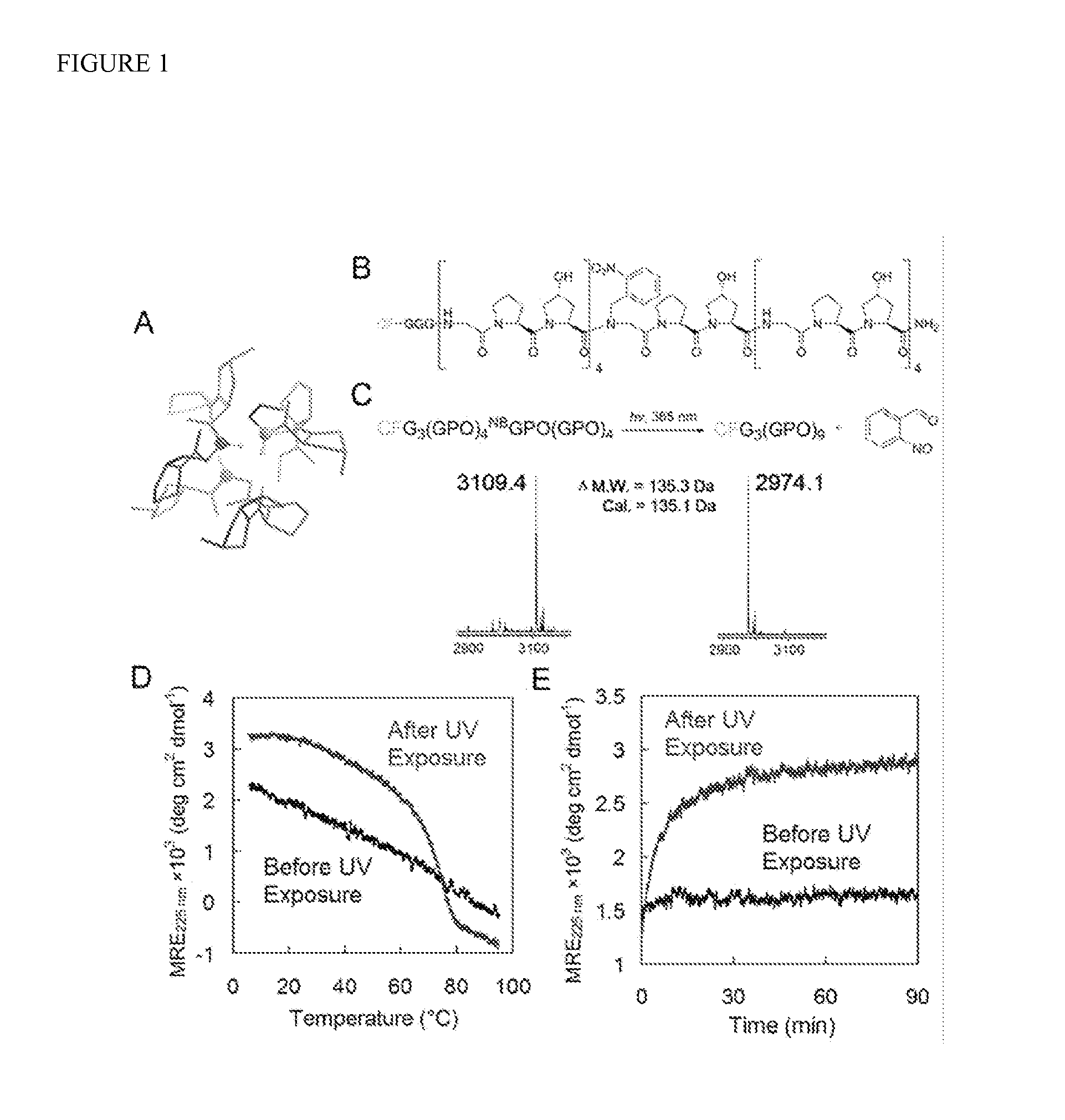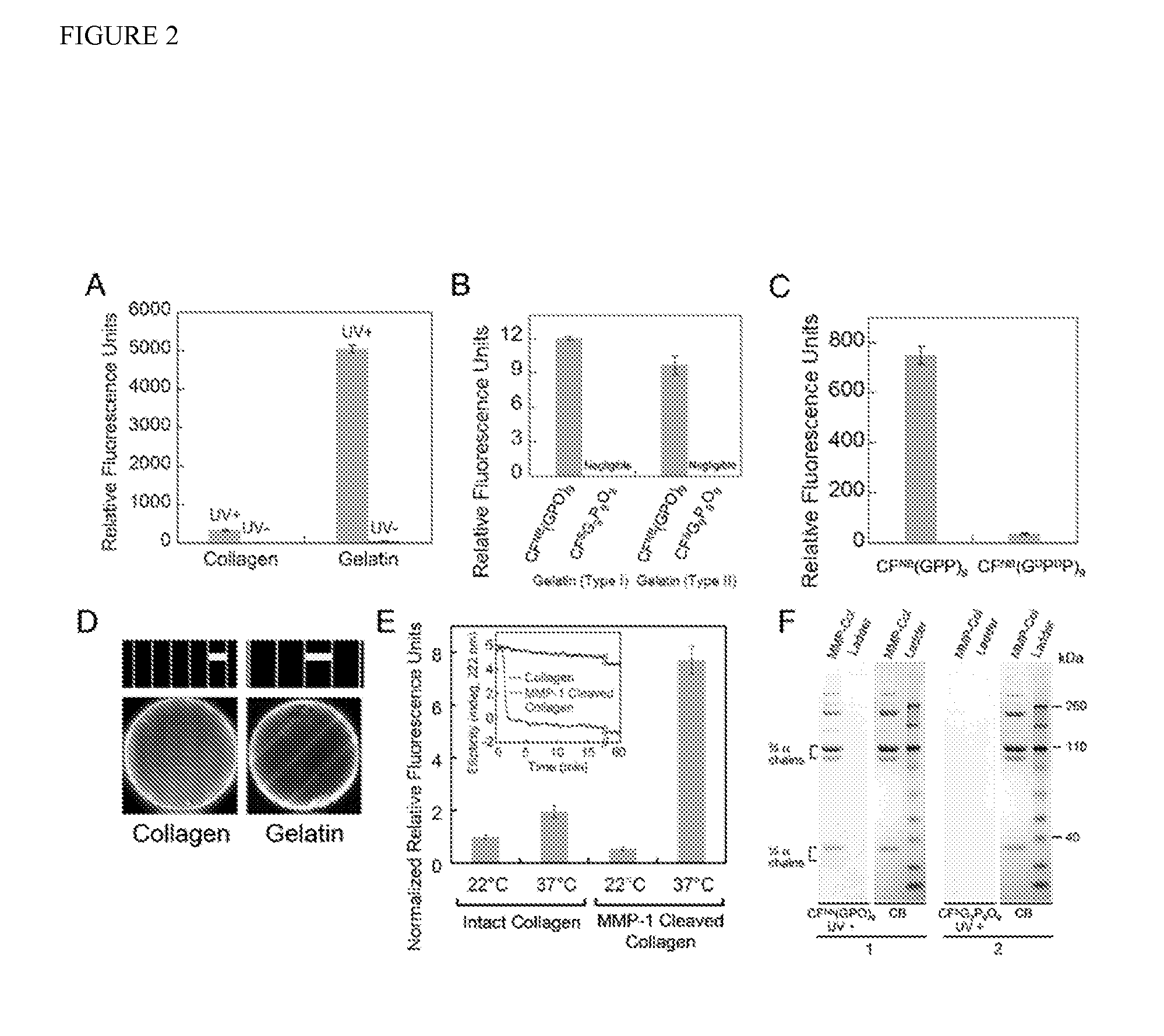Collagen mimetic peptides for targeting collagen strands for in vitro and in vivo imaging and therapeutic use
a technology of collagen strands and mimetic peptides, which is applied in the direction of peptide/protein ingredients, bulk chemical production, instruments, etc., can solve the problems of difficult preparation of anti-collagen antibodies employed in these analyses, poor pharmacokinetics, and low specificity and binding affinity of probes
- Summary
- Abstract
- Description
- Claims
- Application Information
AI Technical Summary
Benefits of technology
Problems solved by technology
Method used
Image
Examples
example 1
Design and Photo-Triggered Folding of the Caged Collagen Mimetic Peptide
[0122]In the collagen triple helix, small Gly residues are periodically located at every third position in each collagen strand to allow close packing of three protein chains in a right-handed twist (FIG. 1A). Mutations at even a single Gly position can destabilize the collagen structure and cause debilitating genetic disease. A large, sterically hindered, photo-cleavable cage group was conjugated to the central Gly nitrogen of the CMP in order to fully negate the CMP's ability to fold (FIG. 5), while exposure to light could liberate the cage group, and trigger triple helix folding and collagen binding. The nitrobenzyl (NB) caged and carboxyfluorescein (CF) labeled CMP of sequence CF-Gly3-(GlyProHyp)4-NBGlyProHyp-(GlyProHyp)4 [designated as CFNB(GPO)9, FIG. 1B] was synthesized by incorporation of Fmoc(N-o-nitrobenzyl)Gly-OH during conventional Fmoc-mediated solid phase peptide synthesis (SPPS). Coupling of Hyp t...
example 2
Photo-Triggered CMP-Collagen Hybridization
[0124]Using the new caged CMP, a comparative study of CMP binding towards intact and thermally denatured (gelatin) type I collagen was performed because collagen denaturation could be completely decoupled from CMP melting. Photo-triggered binding affinity of the caged CMP was studied by applying CFNB(GPO)9 to a 96-well assay microplate coated with collagen / gelatin films, followed by UV (365 nm) exposure and measuring the fluorescence intensity of the collagen films after washing. While caged CMP binding (UV−) remained negligible on both collagen and gelatin substrates, photo-activated caged CMPs (UV+) exhibited binding to both substrates with the level of binding an order of magnitude higher for gelatin (FIG. 2A). These results indicate that CMP's triple helical folding is required for the binding, and collagen denaturation produces unfolded collagen strands that avidly hybridize with photo-decaged CMPs. The binding affinity was further conf...
example 3
In Vivo Tumor Targeting by CMP Hybridization
[0128]To demonstrate CMP's ability to target pathologic tissues of high MMP activity, an in vivo tumor targeting experiment was performed using the same caged CMP conjugated to a near-infrared fluorophore (NIRF). Tumor progression involves proteolytic remodeling of the extracellular matrix (ECM) by various MMPs that results in the accumulation of stromal collagens with a unique structural and biochemical signatures. IRDye-800CW (IR) was conjugated to the N-termini of the caged CMPNB(GPO)9 and the scrambled peptide SG9P9O9 with flexible aminohexanoic acid (Ahx) spacers (FIG. S9 for synthesis and CD melting curves). The NIRF labeled CMPs were rapidly decaged under intense UV light (365 nm, >25 mW / cm2) and immediately injected into the tail vein of mice bearing subcutaneous PC-3 prostate tumor xenografts. Considering the slow folding rate of the CMP triple helix (half time of CMP refolding is approximately 50 minutes) and the short time delay...
PUM
| Property | Measurement | Unit |
|---|---|---|
| Fluorescence | aaaaa | aaaaa |
Abstract
Description
Claims
Application Information
 Login to view more
Login to view more - R&D Engineer
- R&D Manager
- IP Professional
- Industry Leading Data Capabilities
- Powerful AI technology
- Patent DNA Extraction
Browse by: Latest US Patents, China's latest patents, Technical Efficacy Thesaurus, Application Domain, Technology Topic.
© 2024 PatSnap. All rights reserved.Legal|Privacy policy|Modern Slavery Act Transparency Statement|Sitemap



